jsp网上零食销售系统的设计与实现答辩
- 格式:ppt
- 大小:2.32 MB
- 文档页数:31

摘要21世纪以来,人类经济高速发展,人们的生活发生了日新月异的变化,特别是计算机的应用及普及到经济和社会生活的各个领域。
为了让消费者甜品网上购物系统商店过程变得简单、方便、安全、快捷,网上商城购物成了一种新型而热门的购物方式。
甜品网上购物系统商店是一种具有交互功能的商业信息系统,它在网络上建立一个虚拟的购物商城,使购物过程变得轻松、快捷、方便。
然而作为一个购物系统,能够长期健康的发展系统的安全性和实现购物的方便性是很重要的,在安全性方面,系统主要考虑了数据存储的安全性,以及用了用户注册和密码等措施,没有使用到数字签名技术。
在方便性上,主要考虑了用户浏览商品、查询商品、定购商品的方便性和后台管理用户维护的方便性,在用户定购商品后,货单付款,商家把商品送到用户。
课题目标是设计并实现一个甜品网上购物系统网站。
结合实践,理解网页开发技术和数据库的基本知识,学习相关开发工具和应用软件,熟悉网站建设的过程,熟练掌握网络数据库编程方法。
系统采用B/S开发模式,开发工具选择JAVA、JSP、JavaScript、Html 语言,采用Tomcat服务器技术,后台数据库选用SQL Server 2005。
关键词:甜品网上购物系互联网系统设计AbstractIn 21st century, human high-speed economic development, people's life a changing, special is the computer application and popularization to all fields of economic and social life. In order to let the consumer online shopping system stores dessert process become simple, convenient, safe, efficient, online mall shopping became a kind of new-style and popular shopping way. It is to build a virtual shopping mall, make shopping process easier, quick, convenient.However as a shopping system, the development of long-term health to the security of the system and realize the convenience of shopping, it is important to safety, system mainly in the safety of considering the data storage and in user registration and passwords and other measures, no use to digital signature technology. In convenience, the main consideration the users browse goods, inquires the commodity, order the convenience and background management of goods of convenience, the user maintain order goods in the user, the businessman, after the goods invoice payment to the user.Task goal is to design and implement a dessert shopping website system bining the practice, web development technology and understanding the basic knowledge, learning database related development tools and application software, familiar with website construction process, mastering network database programming method. System adopts B/S developing mode, selection of development tools JA V A, JSP,JavaScript, Html, using Tomcat Server technology, backend database choose SQL Server 2005.Key words: Online Shopping System The Internet System Design目录第一章绪论 (1)1.1项目背景与现实价值 (1)1.2开发工具和实用技术 (1)第二章系统分析 (3)2.1需求分析 (3)2.1.1 性能需求 (3)2.1.2 安全需求 (3)2.1.3功能需求 (3)第三章概要设计 (8)3.1系统结构设计 (8)3.1.1 后台功能模块 (9)3.1.2 前台功能模块 (9)第四章数据库设计 (11)4.1 结构设计 (11)4.1.1 概念结构设计 (11)4.1.2 逻辑结构设计 (11)第五章界面设计 (13)5.1 界面设计要求 (13)5.2 系统界面设计 (13)5.3系统页面设计介绍及关系 (14)5.3.1 后台页面说明 (14)5.3.2后台页面之间的跳转.......................... 错误!未定义书签。


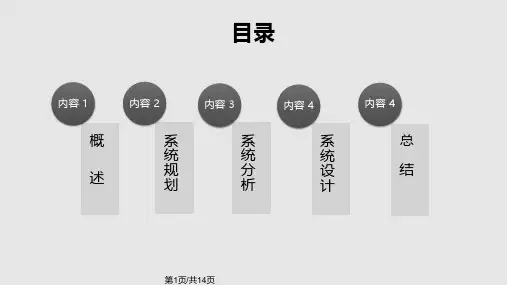
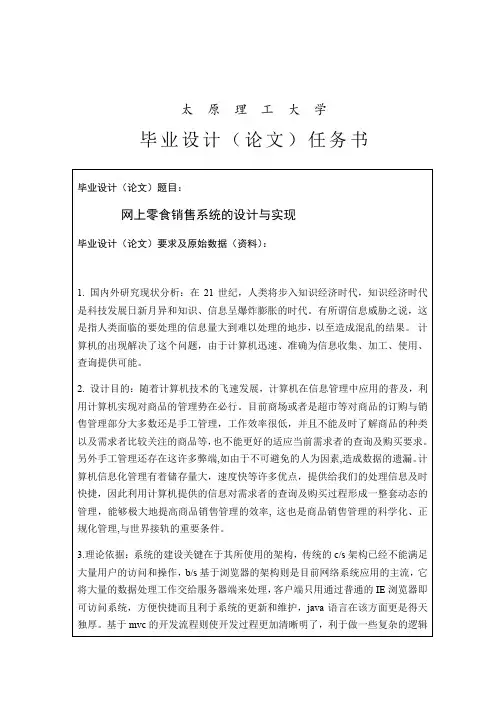
太原理工大学毕业设计(论文)任务书基于JSP的网上零食销售系统的设计与实现摘要随着社会,科技的不断发展也在不断更新。
互联网作为20世纪90年代的新工具开始被用于商业,它在商业社会的快速发展提供了更广阔的平台和更多的商业信息,如催化剂一般带动商业经济的快速发展。
因此,选择一个企业门户的设计和开发的意义。
本文介绍了开发和设计零食销售管理系统。
设计采用现在比较流行的JSP网页开发技术,并考虑到数据处理的网站结构特点和所学,应用Microsoft SQL Server2000数据库系统作为后台站点数据库。
系统实现了网站的基本功能,包括客户登记注册,请访问网站的信息,信息,购物和填写订单和管理员对网站的维护和更新。
在页面设计与制作,网页的基本格式,使用HTML语言的一个大框架,然后用Photoshop和MyEclipse的框架进行详细的设计里面。
结合设计和互联网应用的发展,业务演示做一些事情的意义;然后分析了整个系统,包括可行性分析,需求分析,业务流程,数据分析系统的分析;决定在此基础上的功能目标网站,该网站设有连续分工,并分为若干子功能模块;下一设计和实施中的各种模块,每个模块可导致在完成它的功能集成到一个完整的系统。
关键词:网上商品购买;JSP;HTMDesign and Implementation of JSP's Online Sales SystemBased SnacksAbstractToday,the science techniques develop very fast.People valued the E-business using the modern network proceeds the business activity as the key power more and more.The Business to Customer mode is one of the main trade modes on the net of electronic commercr.Now,the Business to Customer field is in the stage of the beginning.This is good development foreground for the market.Therefore,it is meaning for us to design and develop the electronic commerce website.This paper detail describes how to develop an electronic commerce website.In the design,I used the JSP technology which is very popular during the website developer.Considered with the knowledge that I have learned and the structure of the date that the website deal with,I used Microsoft SQL server 2000 as the back database of the website. It can show us the information of the goods、news、customers that registered on the website and so on.It also can provides the function that some customers on the web can fill in bills when they want to buy the goods. The system realized the query function for products and the manage functions for the background of the system..During the process of designing the webpage,I make the main frame by HTML,and use Photoshop and Eclipse to finish the detailed design.First,I make a instruction for the application and development of Internet in commerce,then analyze the whole system,which includes sibility analyze,requirement analyze,operation flow analyze and date analyze.Then I make the function aim of this website base on the analyses above,and divide the function up to several parts.I design every single part of the function particularly,and finallyintegrate these sub-function modules to one complete system.Keywords:Online Mart; JSP; HTML目录1 引言 .......................................................................................... 错误!未定义书签。

美食系统答辩
以下是关于美食系统答辩的一些建议: 1. 项目概述:简要介绍美食系统的目标、功能和特点。
2. 技术架构:介绍系统所使用的技术栈、框架和开发工具。
3. 功能演示:通过实际操作或演示视频展示系统的主要功能,如菜单浏览、菜品推荐、订单管理等。
4. 数据管理:说明系统如何管理和存储美食数据,包括菜品信息、用户偏好等。
5. 用户体验:强调系统在用户界面设计、交互流程等方面的优势,以及如何提高用户满意度。
6. 安全与隐私:阐述系统在数据安全和用户隐私保护方面所采取的措施。
7. 性能优化:介绍系统在提高性能和响应速度方面所做的努力,如缓存优化、数据库优化等。
8. 项目成果:总结项目开发过程中取得的主要成果和经验教训。
9. 未来展望:讨论系统的改进和扩展方向,以及可能面临的挑战。
10. 问答环节:准备回答评委和观众可能提出的问题,展示对项目的深入理解。
在答辩过程中,要注意表达清晰、简洁,突出系统的亮点和创新之处。
同时,要对评委的提问给予耐心和细致的回答,展示自己的专业素养和技术能力。
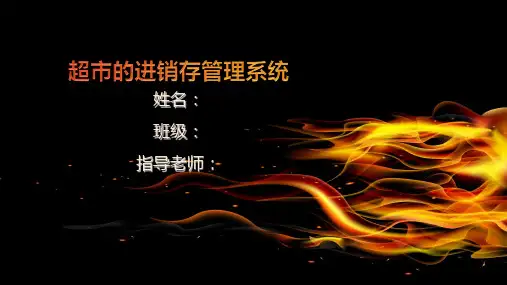
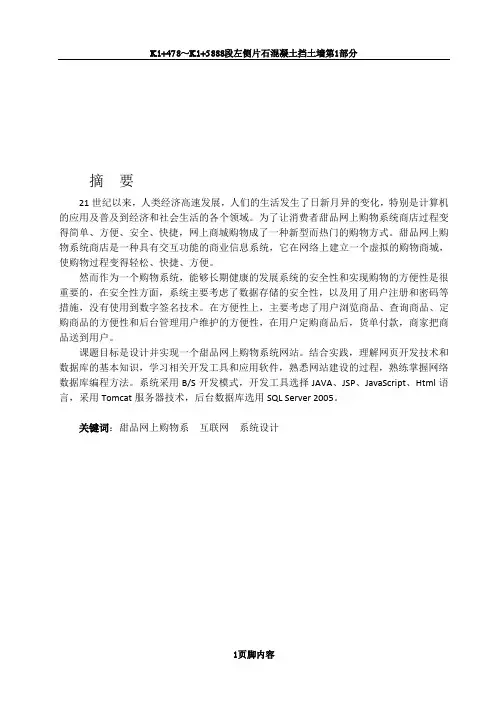
摘要21世纪以来,人类经济高速发展,人们的生活发生了日新月异的变化,特别是计算机的应用及普及到经济和社会生活的各个领域。
为了让消费者甜品网上购物系统商店过程变得简单、方便、安全、快捷,网上商城购物成了一种新型而热门的购物方式。
甜品网上购物系统商店是一种具有交互功能的商业信息系统,它在网络上建立一个虚拟的购物商城,使购物过程变得轻松、快捷、方便。
然而作为一个购物系统,能够长期健康的发展系统的安全性和实现购物的方便性是很重要的,在安全性方面,系统主要考虑了数据存储的安全性,以及用了用户注册和密码等措施,没有使用到数字签名技术。
在方便性上,主要考虑了用户浏览商品、查询商品、定购商品的方便性和后台管理用户维护的方便性,在用户定购商品后,货单付款,商家把商品送到用户。
课题目标是设计并实现一个甜品网上购物系统网站。
结合实践,理解网页开发技术和数据库的基本知识,学习相关开发工具和应用软件,熟悉网站建设的过程,熟练掌握网络数据库编程方法。
系统采用B/S开发模式,开发工具选择JAVA、JSP、JavaScript、Html语言,采用Tomcat服务器技术,后台数据库选用SQL Server 2005。
关键词:甜品网上购物系互联网系统设计AbstractIn 21st century, human high-speed economic development, people's life a changing, special is the computer application and popularization to all fields of economic and social life. In order to let the consumer online shopping system stores dessert process become simple, convenient, safe, efficient, online mall shopping became a kind of new-style and popular shopping way. It is to build a virtual shopping mall, make shopping process easier, quick, convenient.However as a shopping system, the development of long-term health to the security of the system and realize the convenience of shopping, it is important to safety, system mainly in the safety of considering the data storage and in user registration and passwords and other measures, no use to digital signature technology. In convenience, the main consideration the users browse goods, inquires the commodity, order the convenience and background management of goods of convenience, the user maintain order goods in the user, the businessman, after the goods invoice payment to the user.Task goal is to design and implement a dessert shopping website system bining the practice, web development technology and understanding the basic knowledge, learning database related development tools and application software, familiar with website construction process, mastering network database programming method. System adopts B/S developing mode, selection of development tools JA V A, JSP,JavaScript, Html, using Tomcat Server technology, backend database choose SQL Server 2005.Key words: Online Shopping System The Internet System Design目录第一章绪论11.1项目背景与现实价值11.2开发工具和实用技术1第二章系统分析32.1需求分析32.1.1 性能需求32.1.2 安全需求32.1.3功能需求3第三章概要设计73.1系统结构设计73.1.1 后台功能模块73.1.2 前台功能模块8第四章数据库设计94.1 结构设计94.1.1 概念结构设计94.1.2 逻辑结构设计10第五章界面设计115.1 界面设计要求115.2 系统界面设计125.3系统页面设计介绍及关系125.3.1 后台页面说明125.3.2后台页面之间的跳转145.3.3前台页面说明145.3.4前台页面之间的跳转15第六章详细设计与实现166.1 系统功能模块166.1.1管理员登录模块166.1.2管理员修改密码模块166.1.3会员管理模块166.1.4品牌管理模块176.1.5甜品管理模块176.1.6新闻管理模块186.1.7会员登录模块196.1.8会员注册模块196.1.9会员购物车模块206.1.10会员订单模块206.1.11会员修改信息模块206.1.12浏览者浏览信息模块216.2 系统采用的数据库连接方式21 总结22致谢23参考文献24第一章绪论1.1项目背景与现实价值在当前信息化的时代,对大众的订餐要求仅仅依赖手工操作,已经远远不能满足实际的需求了,所以网上订餐越来越被看好。
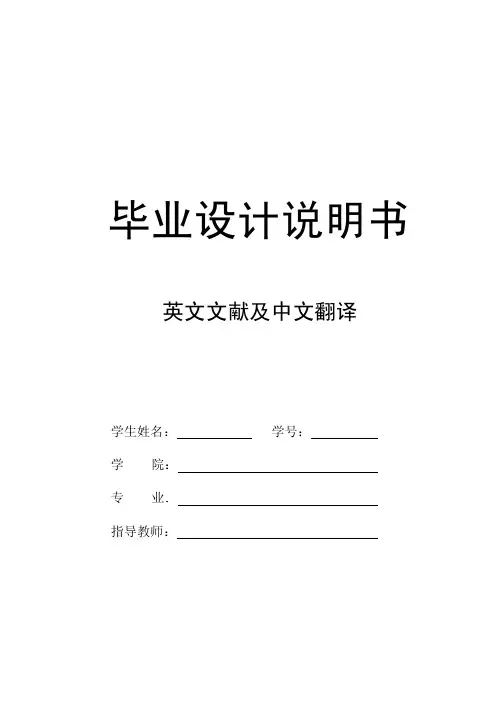
毕业设计说明书英文文献及中文翻译学生姓名:学号:学院:专业:指导教师:Struts——an open-source MVC implementationBy: Malcolm Davis.Source: Struts--an open-source MVC implementation[J].IBM Systems JournalThis article introduces Struts, a Model-View-Controller implementation that uses servlets and JavaServer Pages (JSP) technology. Struts can help you control change in your Web project and promote specialization. Even if you never implement a system with Struts,you may get some ideas for your future servlets and JSP page implementation.IntroductionKids in grade school put HTML pages on the Internet. However, there is a monumental difference between a grade school page and a professionally developed Web site. The page designer (or HTML developer) must understand colors, the customer, product flow, page layout, browser compatibility, image creation, JavaScript, and more. Putting a great looking site together takes a lot of work, and most Java developers are more interested in creating agreat looking object interface than a user interface. Java Server Pages (JSP) technology provides the glue between the page designer and the Java developer.If you have worked on a large-scale Web application, you understand the term change.Model-View-Controller (MVC) is a design pattern put together to help control change. MVC decouples interface from business logic and data. Struts is an MVC implementation that uses Servlets 2.2 and JSP 1.1 tags, from the J2EE specifications, as part of the implementation. Y ou may never implement a system with Struts, but looking at Struts may give you some ideas on your future Servlets and JSP implementations.Model-View-Controller (MVC)JSP tags solved only part of our problem. We still have issues with validation, flow control, and updating the state of the application. This is where MVC comes to the rescue.MVC helps resolve some of the issues with the single module approach by dividing theproblem into three categories:• ModelThe model contains the core of the application's functionality. The model encapsulates thestate of the application. Sometimes the only functionality it contains is state. It knows nothing about the view or controller.• View• The view provides the presentation of the model. It is the look of the application. The view can access the model getters, but it has no knowledge of the setters. In addition, it knows nothing about the controller. The view should be notified when changes to the model occur. ControllerThe controller reacts to the user input. It creates and sets the model.MVC Model 2The Web brought some unique challenges to software developers, most notably the stateless connection between the client and the server. This stateless behavior made it difficult for the model to notify the view of changes. On the Web, the browser has to re-query the server to discover modification to the state of the application.Another noticeable change is that the view uses different technology for implementation than the model or controller. Of course, we could use Java (or PERL, C/C++ or what ever) code to generate HTML. There are several disadvantages to that approach:• Java programmers should develop services, not HTML.• Changes to layout would require changes to code.• Customers of the service should be able to create pages to meet their specific needs.• The page designer isn't able to have direct involvement in page development.• HTML embedded into code is ugly.For the Web, the classical form of MVC needed to change.MVC Model 2 Struts, an MVC 2 implementation Struts is a set of cooperating classes, servlets, and JSP tags that make up a reusable MVC 2 design. This definition implies that Struts is a framework, rather than a library, but Struts also contains an extensive tag library and utility classes that work independently of the framework.• Client browserAn HTTP request from the client browser creates an event. The Web container will respond with an HTTP response.• ControllerThe Controller receives the request from the browser, and makes the decision where to send the request. With Struts, the Controller is a command design pattern implemented as a servlet. The struts-config.xml file configures the Controller.• Business logicThe business logic updates the state of the model and helps control the flow of the application.With Struts this is done with an Action class as a thin wrapper to the actual business logic.• Model stateThe model represents the state of the application. The business objects update the application state. ActionForm bean represents the Model state at a session or request level, and not at a persistent level. The JSP file reads information from the ActionForm bean using JSP tags.• ViewThe view is simply a JSP file. There is no flow logic, no business logic, and no model information -- just tags. Tags are one of the things that make Struts unique compared to other frameworks like V elocity.Struts detailsDisplayed in Figure 6 is a stripped-down UML diagram of the org.apache.struts.action package and shows the minimal relationships among ActionServlet (Controller), ActionForm (Form State), and Action (Model Wrapper).The ActionServlet classDo you remember the days of function mappings? Y ou would map some input event to a ointer to a function. If you where slick, you would place the configuration information into ale and load the file at run time. Function pointer arrays were the good old days of structured rogramming in C.Life is better now that we have Java technology, XML, J2EE, and all that. The Struts ontroller is a servlet that maps events (an event generally being an HTTP post) to classes. guess what -- the Controller uses a configuration file so you don_t have to hard-code the alues. Life changes, but stays the same.ActionServlet is the Command part of the MVC implementation and is the core of the ramework. ActionServlet (Command) creates and uses Action, an ActionForm, and ctionForward. As mentioned earlier, the struts-config.xml file configures the command. uring the creation of the Web project, Action and ActionForm are extended to solve the pecific problem space. The file struts-config.xml instructs ActionServlet on how to use the xtended classes. There are several advantages to this approach:• The entire logical flow of the application is in a hierarchical text file. This makes itasier to view and understand, especially with large applications.• The page designer does not have to wade through Java code to understand the flow of e application.• The Java developer does not need to recompile code when making flow changes. Command functionality can be added by extending ActionServlet.The ActionForm classActionForm maintains the session state for the Web application. ActionForm is anbstract class that is sub-classed for each input form model. When I say input form model, Im saying ActionForm represents a general concept of data that is set or updated by a HTML form. For instance, you may have a UserActionForm that is set by an HTML Form. The Struts framework will:• Check to see if a UserActionForm exists; if not, it will create an instance of the class.• Struts will set the state of the UserActionForm using corresponding fields from the HttpServletRequest. No more dreadful request.getParameter() calls. For instance, the Struts framework will take fname from request stream and call UserActionForm.setFname().• The Struts framework updates the state of the UserActionForm before passing it to the business wrapper UserAction.• Before passing it to the Action class, Struts will also conduct form state validation by calling the validation() method on UserActionForm. Note: This is not always wise to do. There might be ways of using UserActionForm in other pages or business objects, where the validation might be different. V alidation of the state might be better in the UserAction class.• The UserActionForm can be maintained at a session level.Notes:• The struts-config.xml file controls which HTML form request maps to which ActionForm. • Multiple requests can be mapped UserActionForm.• UserActionForm can be mapped over multiple pages for things such as wizards.The Action classThe Action class is a wrapper around the business logic. The purpose of Action class is to translate the HttpServletRequest to the business logic. To use Action, subclass and overwrite the process() method.The ActionServlet (Command) passes the parameterized classes to ActionForm using the perform() method. Again, no more dreadful request.getParameter() calls. By the time the event gets here, the input form data (or HTML form data) has already been translated out of the request stream and into an ActionForm class.Note: "Think thin" when extending the Action class. The Action class should control the flow and not the logic of the application. By placing the business logic in a separate package or EJB, we allow flexibility and reuse.Another way of thinking about Action class is as the Adapter design pattern. The purpose of the Action is to "Convert the interface of a class into another interface the clients expect. Adapter lets classes work together that couldn_t otherwise because of incompatibility interface" (from Design Patterns - Elements of Reusable OO Software by Gof). The client in this instance is the ActionServlet that knows nothing about our specific business class interface. Therefore, Struts provides a business interface it does understand, Action. By extending the Action, we make our business interface compatible with Struts business interface. (An interesting observation is that Action is a class and not an interface. Action started as an interface and changed into a class over time. Nothing's perfect.)The Error classesThe UML diagram (Figure 6) also included ActionError and ActionErrors. ActionError encapsulates an individual error message. ActionErrors is a container of ActionError classes that the View can access using tags. ActionErrors is Struts way of keeping up with a list of errors.UML diagram of the relationship of the Command (ActionServlet) to the Model (Action) The ActionMapping classAn incoming event is normally in the form of an HTTP request, which the servlet Container turns into an HttpServletRequest. The Controller looks at the incoming event and dispatches the request to an Action class. The struts-config.xml determines what Action class the Controller calls. The struts-config.xml configuration information is translated into a set of ActionMapping, which are put into container of ActionMappings. (If you have not noticed it, classes that end with s are containers) The ActionMapping contains the knowledge of how a specific event maps to specific Actions. The ActionServlet (Command) passes the ActionMapping to the Action class via the perform() method. This allows Action to access the information to control flow.ActionMappingsActionMappings is a collection of ActionMapping objects.Struts pros Use of JSP tag mechanism The tag feature promotes reusable code and abstracts Java code from the JSP file. This feature allows nice integration into JSP-based development tools that allow authoring with tags.• Tag libraryWhy re-invent the wheel, or a tag library? If you cannot find something you need in the library, contribute. In addition, Struts provides a starting point if you are learning JSP tag technology.• Open sourceY ou have all the advantages of open source, such as being able to see the code and having everyone else using the library reviewing the code. Many eyes make for great code review.• Sample MVC implementationStruts offers some insight if you want to create your own MVC implementation.• Manage the problem spaceDivide and conquer is a nice way of solving the problem and making the problem manageable.中北大学2014届毕业设计英文文献译文Struts 一个开源的MVC实现作者:马尔科姆·戴维斯。
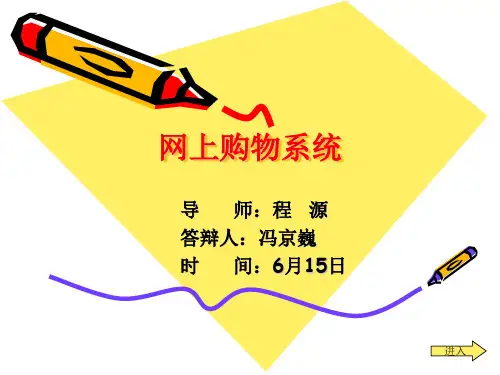
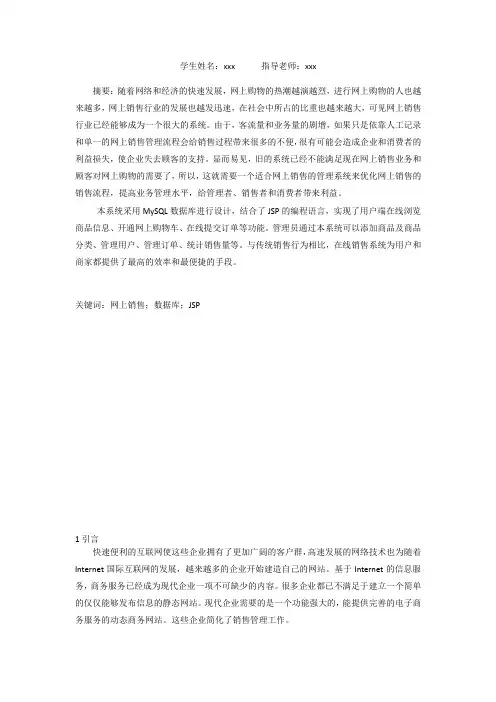
学生姓名:xxx 指导老师:xxx摘要:随着网络和经济的快速发展,网上购物的热潮越演越烈,进行网上购物的人也越来越多,网上销售行业的发展也越发迅速,在社会中所占的比重也越来越大,可见网上销售行业已经能够成为一个很大的系统。
由于,客流量和业务量的剧增,如果只是依靠人工记录和单一的网上销售管理流程会给销售过程带来很多的不便,很有可能会造成企业和消费者的利益损失,使企业失去顾客的支持。
显而易见,旧的系统已经不能满足现在网上销售业务和顾客对网上购物的需要了,所以,这就需要一个适合网上销售的管理系统来优化网上销售的销售流程,提高业务管理水平,给管理者、销售者和消费者带来利益。
本系统采用MySQL数据库进行设计,结合了JSP的编程语言,实现了用户端在线浏览商品信息、开通网上购物车、在线提交订单等功能。
管理员通过本系统可以添加商品及商品分类、管理用户、管理订单、统计销售量等。
与传统销售行为相比,在线销售系统为用户和商家都提供了最高的效率和最便捷的手段。
关键词:网上销售;数据库;JSP1引言快速便利的互联网使这些企业拥有了更加广阔的客户群,高速发展的网络技术也为随着Internet国际互联网的发展,越来越多的企业开始建造自己的网站。
基于Internet的信息服务,商务服务已经成为现代企业一项不可缺少的内容。
很多企业都已不满足于建立一个简单的仅仅能够发布信息的静态网站。
现代企业需要的是一个功能强大的,能提供完善的电子商务服务的动态商务网站。
这些企业简化了销售管理工作。
网上销售系统是电子商务发展下应运而生的产物,是网络技术应用的一个发展方向。
网上销售平台是对后台管理和前台操作。
后台管理是管理员对本网站的维护,通过商品资料(商品添加、商品修改),以及常规设置(广告添加,友情链接)等功能达到对网站的管理。
前台操作是用户登录到本网站,可以进行用户注册,通过网站的精品推荐或商品搜索功能,找到自己想要买的商品,装入购物车,提交定单进行购买。
廣東技術師範大学天河學院期末作业项目书项目名称: 零食商城系统的设计与实现项目负责人: 吴茂奕所属学院:计算机科学与工程指导老师: 胡安明、钟桂凤完成时间:2019-6-12零食商城系统的设计与实现摘要近年来,随着我国互联网的普及,网上商城的悄然兴起,是商业经济发展到一定阶段的产物,也是顺应新的消费需求和技术进步的必然结果。
本文研究了一个网上零食商城系统,该系统是一个基于SSM框架,采用B/S 模式,并根据现有的网上购物系统设计优化而成。
系统主要以Java语言作为开发基础,使用了Jsp+Sping+SpringMVC+Mybatis等技术,采用MyEclipse作为开发工具,以MySQL作为数据库工具。
本系统分有两个子系统,前台系统和后台管理系统,其中前台系统主要包括商城首页、零食详情、用户注册、用户登录、购物车、提交订单、个人中心等信息;后台管理系统实现了商城管理的基本功能,包括:用户信息管理模块、零食管理模块、图片管理模块、订单管理模块、营业额图表统计模块。
管理员通过上述功能可以更好的管理网上零食商城。
本系统具有多方面特点:系统功能完备,使用方便简捷,人性化的用户界面,节省经营成本,大大减少了操作人员的工作负担。
关键词:零食商城系统SSM MySQL Jsp目录摘要..................................................................................................................................................... I I 第一章绪论.. (1)1.1课题背景、目的及意义 (1)1.1.1 课题背景 (1)1.1.2 课题目的和意义 (1)1.2国内外研究现状 (2)1.2.1 国内的研究现状 (2)1.2.2 国外的研究现状 (3)第二章相关技术介绍 (5)2.1J A V ASCRIPT (5)2.2A JAX (5)2.3M Y SQL (5)2.4SSM框架 (5)2.5JSP (6)2.6B/S模式 (7)2.7E ASY UI (8)2.8系统开发平台及运行环境 (8)2.8.1 系统开发平台 (8)2.8.2 运行环境 (9)第三章系统需求分析 (10)3.1功能需求分析 (10)3.2非功能需求分析 (14)3.3可行性分析 (14)3.3.1 经济可行性 (14)3.3.2 技术可行性 (14)第四章系统设计 (16)4.1系统架构 (16)4.2系统功能模块设计 (16)4.3系统工作流程设计 (18)4.4数据库设计 (18)4.4.1 数据库概念设计 (18)4.4.2 数据库逻辑设计 (22)第五章零食商城系统实现 (26)5.1用户模块 (26)5.1.1 首页 (26)5.1.2 零食分类 (27)5.1.3 零食信息 (27)5.1.4 购物车 (28)5.1.5 用户注册 (28)5.1.6 用户登录 (28)5.1.7 个人中心 (29)5.1.8 订单 (29)5.2管理员模块 (30)5.2.1 管理员登录 (30)5.2.2用户管理 (31)5.2.3 图片管理 (32)5.2.4 订单管理 (33)5.2.5 零食管理 (34)5.2.6 营业额统计 (35)第六章系统测试 (36)6.1测试的目的与目标 (36)6.2测试方法 (36)结论与展望 (38)参考文献 (39)第一章绪论1.1 课题背景、目的及意义1.1.1 课题背景随着网络技术的发展,网络平台日益稳定,越来越多的人喜欢在网上交友购物。
编号:审定成绩:毕业设计(论文)设计(论文)题目:基于JSP技术的企业商品展示网站设计与实现学院名称:计算机科学与技术学院学生姓名:专业:班级:学号:指导教师:答辩组负责人:填表时间:2011年 5 月重庆邮电大学教务处制摘要随着计算机网络的发展,商品贸易也不再仅仅局限于现实生活中进行,更大的市场拓向了网络,这个庞大的信息传输工具。
正是在这样一个网络化的商业市场里,结合自己所学的知识,运用JavaScript程序设计技术,作者开始了本门窗建材产品网站的开发,这使得人们领略网络购物的方便。
在这里,你可以看到我公司最近的产品,可以比较同种价位的商品与我公司产品的差距,让您买到称心如意的商品。
本系统采用了JavaScript技术、微软的Access数据库、My eclipse为开发工具。
在系统开发过程中运用软件工程导论,让网站从最初的可行性研究到需求分析,总体设计、详细设计、实现再到维护与升级,在很大一定的程度上保证了网络的可行性。
本文介绍了制作该网站的全过程。
从选题分析、网站分析、网站实现到网站的测试,列举了大量的实例帮助读者全面了解该网站。
本文的结构可以分为四个部分。
第一部分:选题分析,介绍了选题的目的及意义,使读者能够粗略的了解我所要制作的网站面貌以及实现的功能。
第二部分:网站分析,运用软件工程的知识,从技术和非技术两个方面,全面的分析该网站的需求。
第三部分:网站实现,这是本文的重点,列举了大量的截图、代码来表述网站各种功能的实现。
第四部分:网站的测试与维护,介绍了该网站在完成后所做的测试,以及后期的维护过程。
预设了将来会出现BUG的可能性,及解决的方法。
希望在读者阅读完本文后,会对该网站有一个全面的了解,由于作者水平有限,文中难免存在不足和错误之处,敬请广大读者批评指正。
【关键词】网站建设JavaScript 数据库技术ABSTRACTWith the development of computer network, merchandise trade is no longer limited to real life, greater market to the network topology information transmission, this massive tool. It is in such a network in the business market, combining with the knowledge they learned, using JavaScript programming technology started this door building materials products website development, this makes people appreciate the convenience of Internet shopping. Here, you can see my company recently products, can compare the same price goods and products of our company gap, let you buys goods.This system uses a JavaScript technology, Microsoft access database, the My eclipse for development tool. In system development using the software engineering, let websites from initial introduction to demand analysis of the feasibility study, overall design, detailed design, implementation to maintenance and upgrades, in a certain extent, guarantee the network's feasibility.This paper introduces the whole process of making the website. From the topic analysis, website analyses, realizes the site test site, lists the large number of examples to help readers to fully understand this site. This structure can be divided into four parts.Part 1: topic analysis, introduced the expatiating the purpose and significance, so that readers can understand me to roughly production site appearance as well as the realization of the function.Part 2: website analyses, using the software engineering knowledge, from a technical and non-technical two respects, a comprehensive analysis of the web site needs.Part 3: website implementation, this is this key, lists the large amounts of screenshots, code to describe the realization of the function of website various.Part 4: the site testing and maintenance, introduces the website in complete, the test, and later the maintenance process. Presuppose the possibility of BUG will arise, and the solving methods.Hope in the reader read this article to the website, will have a comprehensive understanding of, since the author level, the paper unavoidably limited defects and mistakes, please readers criticism and corrections.【Key words】Enterprise website,JavaScript,Database technology目录前言 (1)第一章选题分析 (2)一、选题目的及意义 (2)二、研究内容 (2)第二章网站分析 (4)第一节功能需求 (4)一、系统分析 (4)二、需求分析 (6)三、网站 (11)第二节非功能需求 (16)一、性能要求 (16)二、全保密性要求 (16)三、灵活性要求 (16)第三章网站的实现 (17)第一节网页设计 (17)一、总体设计 (17)二、数据库设计 (20)第二节功能实现 (22)一、管理员登入界面的实现 (22)二、后台管理界面的实现 (25)三、查看产品界面的实现 (28)四、在线留言界面的实现 (30)第四章网站测试及维护 (34)第一节网络测试 (34)一、测试目的 (34)二、测试实施 (34)三、测试结论 (34)第二节网络维护及升级 (35)一、网站维护 (35)二、升级 (35)结论 (36)致谢 (37)参考文献 (38)附录 (40)一、英文原文: (40)二、英文翻译: (44)前言当今网络浪潮席卷全球联网、企业网站、电子商务(B2B、B2C)成为最热门的话题,网络为企业的发展创造了全新的机遇,先行一步必然获得无限商机,而给投资者也将获得非常好的回报。